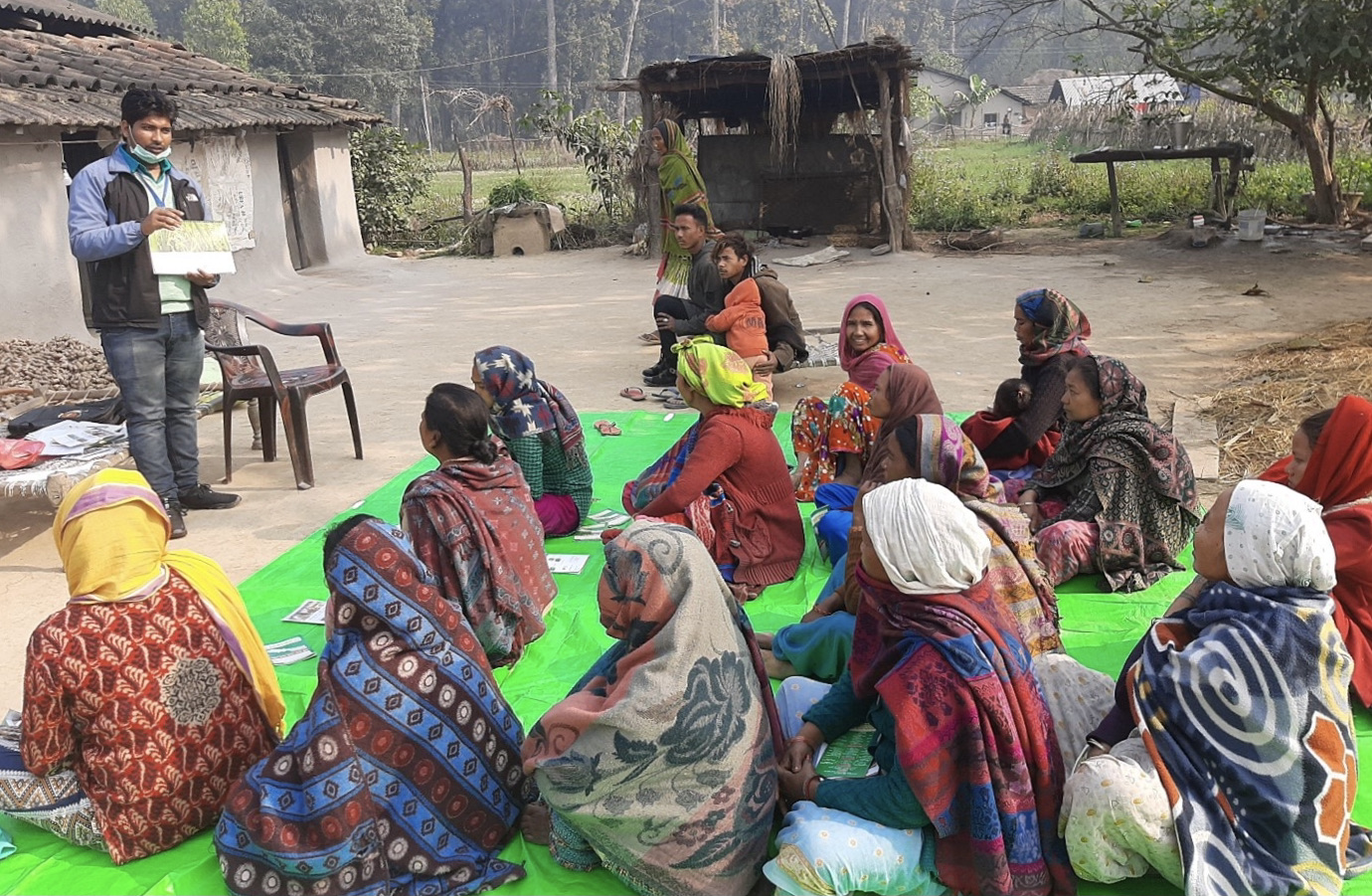April 21st is World Creativity and Innovation Day, an occasion to reaffirm the importance of these principles and how we embrace ideas that provide new momentum for economic growth and innovative solutions. It is a time to recognize the progress made and collective efforts to tackle the most critical global issues such as food and water security, climate crisis and clean energy, gender inequality, and poverty.

To explore creativity and innovation in the water-energy-food nexus, Wanweena Tangsathianraphap, Communications and Knowledge Management Specialist from the WE4F South and Southeast Asia Regional Innovation Hub, conducted a series of interviews with three of the Asia EDGE Agriculture Energy Prize winners to find out what creativity and innovation mean to them, and how they mobilize these principles while bringing change to the region.
In this first interview, Wanweena spoke with Bishwaraj Bhattarai, Project Manager at Gham Power, a social enterprise focused on renewable energy. Gham Power is based in Kathmandu, Nepal.
IN YOUR OPINION, WHAT IS THE CULTURE OF INNOVATION? HOW DO YOU DEFINE IT AND WHAT DOES IT MEAN TO YOU?
Bishwaraj: For me, innovation is anything that brings improvement, incremental or substantial, in any process, product or service. While creativity and innovation are often understood to be relevant only for shift[ing] paradigm and ‘revolutionary’ changes…continuous and incremental ‘evolutionary’ changes are also equally important. A culture that fosters and encourages people and teams to ideate, design, implement, and measure the impact of both evolutionary and revolutionary improvements can be termed as a culture that promotes innovation. Enabling people to own their ideas and measuring impact of the innovation to further refine and replicate them [has] become especially important in sustaining the innovation and the culture.
TALKING ABOUT THE INNOVATION AT GHAM POWER, HOW DO YOU COME UP WITH IDEAS FOR THIS INNOVATIVE SOLUTION? WHERE IS THE SOURCE OF INSPIRATION?
Bishwaraj: Our innovation is an integrated solution that helps small farmers adopt modern agriculture and improve their productivity through the access of reliable irrigation, financing, and personalized advisory services. Iterating and refining our solution, which started from a standalone solar water pump, to progressively address the fundamental problems of the farmers, has been the guiding principle in our journey.

A solar water pump in action. Rural farmers spend anywhere from $5 to $15 per hour on rented diesel-based systems. Expensive irrigation limits the ability to plant high value crops, and increase crop cycle, thus reducing overall income.
WHY DO YOU THINK YOUR INNOVATION WORKS WELL? WHAT IS THE RESULT SO FAR?
Bishwaraj: Our solution helps to address some of the fundamental problems faced by small farmers in Nepal, like, lack of irrigation, poor access to financing, lack of training and skills to adopt commercial farming, etc. Consequently, an integrated approach to address these issues has helped farmers significantly, which is evident from the fact that farmers have achieved over 20% increase in land acreage and over 80% increase in income.
In addition, our solution also works with and specially targets women and bottom of the pyramid farmers. Over 55% of all personnel, both office and field based, involved in delivering our solution to the last mile farmers comprise of women. 100% of our primary touch points are women, for example the first step in promoting and deploying our solution involves training and educating women members of our micro-finance (MFI) partners. Further, over three quarters of our primary beneficiaries are either women–led households or members of traditionally disadvantaged groups and underprivileged communities.

Gham Power’s field staff explain the benefits of solar irrigation and the potential to increase income by planting commercial crops to members (mostly women) of the partner micro-finance.
LOOKING BACK, HOW WAS IT BEFORE YOU WON THE AWARD AND WHAT HAS CHANGED AFTER JOINING THE PROGRAM? WHAT HAVE YOU DONE WITH THE GRANT/TECHNICAL ASSISTANCE RECEIVED?
Bishwaraj: The award has helped us grow, primarily in two ways. The funding has allowed [us] to continue refine our solutions so that (a) we can progressively serve farmers at the base of the pyramid, and (b) the impact on each farmer can be further improved and measured. The recognition and technical assistance have helped us build new partnerships, which will not only improve our solution offering to the farmers (holistic solution[s] requires partnership with multiple stakeholders and expertise), but also to replicate our solution to new demographics and new geographies.
SINCE LAST YEAR, COVID-19 HAS HAD SIGNIFICANT IMPACTS ON MANY BUSINESSES AROUND THE WORLD. DOES YOUR COMPANY FACE ANY CHALLENGES? IF SO, HOW HAVE YOU PIVOTED TO RE-INNOVATE AND GET CREATIVE DURING THIS DIFFICULT TIME?
Bishwaraj: Like many, our operations have also been affected by the pandemic. Our work is based on extensive field activities. Meeting farmers, educating, and training them, demonstrating new technologies, etc. [are needed] to generate awareness about solar powered irrigation and the potential to modernize agriculture. All these activities came to a grinding halt for almost a greater half of 2020. During th[is] time, however, we used digital meetups, telephones, and SMS to continue [to] remain in touch with our farmers, provide them with consultation and advisory. As farmers were having [a] hard time accessing agri-inputs for new plantation and sell[ing] their produce due to movement restrictions and lockdowns, we mapped input suppliers, buyers and helped the farmers connect with them.
APART FROM AN UNEXPECTED SITUATION LIKE COVID-19, WHAT DO YOU THINK IS THE MAIN CHALLENGE FOR ENTREPRENEURS? WHY ARE COMPANIES STRUGGLING TO INNOVATE EFFECTIVELY NOWADAYS?
Bishwaraj: I think companies continue to innovate, although the proportion of those who become successful in commercializing and sustaining the innovation and the business, may be decreasing. From our experience, the success or failure of an innovation or an enterprise, essentially stems from the innovators understanding – or lack of it – of few fundamental aspects. Like, what problem is the innovation solving for the intended end-user, is the problem worth solving, and if so, who is willing to pay, and how much to have it solved. In [an] economy flooded with data and buzz words, it is not incredibly difficult to get lost in the noise, and find solutions to non-existent problems, or worse, create problems and offer to solve them.
HOW DO WE DEVELOP AND ENCOURAGE THE CULTURE OF CREATIVITY AND INNOVATION AMONG ENTREPRENEURS? WHAT WOULD YOU RECOMMEND TO THEM?
Bishwaraj: [The first step is to] create an environment that allows, or better, actively encourages people to dive deep into potential users’ problems; empathizing with their situation can help teams generate useful ideas. The second step is to have mutual respect and fair discussion of all ideas and innovations, both evolutionary and revolutionary, allowing people and teams to take ownership of the ideas/innovations. Finally, it is important to test, measure, and refine the performance of the ideas against benchmarks that help us understand how effective the ideas are in solving the initial problems, and how to improve them. Then, it’s all about iterating and refining the solution!

Founded in 2010, Gham Power Nepal Private Limited is a renewable-energy focused social enterprise based in Kathmandu, Nepal. Having installed over 2500 solar projects that cumulatively generate 2.5 MW of electricity, Gham played its part in urban electrification and soon after shifted focus to under-served rural markets by 2013. Gham Power won the Asia EDGE Ag-Energy Prize “1st Runner-Up, Mid- Stage Category,” in 2020.

Wanweena Tangsathianraphap is a Communications and Knowledge Management Specialist for the WE4F South and Southeast Asia Regional Innovation Hub. She helps connect people together and bridge the gaps created by time, distance and culture through various communication tools. She believes in the power of knowledge sharing that it helps transform one’s ideas and shape personal view towards the world.

